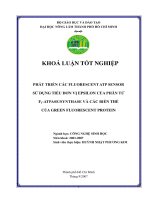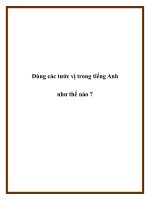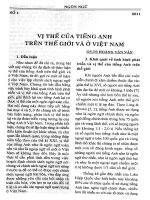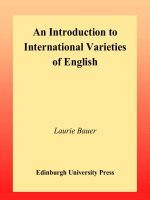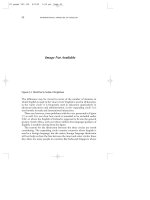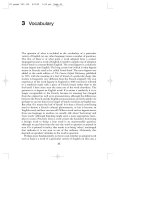Các biến thể của tiếng anh part 14 pdf
Bạn đang xem bản rút gọn của tài liệu. Xem và tải ngay bản đầy đủ của tài liệu tại đây (132.65 KB, 10 trang )
changes would be necessary to make this a consistent text. (iv) The use
of single <l> is North American, so we would have to change fantasise,
honour and centre to make a consistent text. (v) Center is only North
American (especially US), and so fantasise, honour and travelling would
have to be changed to make this a consistent text. (vi) Gipsy with an <i>
is much more likely to be American than British, but could be either, so
that nothing else would have to be changed to make a consistent text.
5. In some cases it may be possible to read a whole book without the
spelling giving absolutely clearcut information on its origin, although
some relatively common words like centre or colour are likely to appear.
The topic, if not the text type, is likely to be a big influence: something
discussing the honours system will give many clues in the form of the
word honour, if not in other ways. The same is true with vocabulary: a
work on cars is likely to be more readily identifiable as either British or
American than a work on geophysics – at least where the vocabulary is
concerned.
Chapter 6
1. If you take a phrase such as The bicycle is at my friend’s house tonight; I’ve
lent it to him, there is nothing in the phonemes or in the distribution of
phonemes or in the pronunciation of individual lexical items which
would tell you specifically about the origin of a speaker who uttered it.
Nonetheless, you would probably easily identify a person who spoke just
those few words as coming from the US, Canada, England, Australia,
New Zealand or South Africa, if you were attuned to those varieties.
This suggests that the most important feature is the phonetic realisation
of the particular sounds. Other things may be easier to talk about,
and possibly more convincing, but the primary evidence will be in the
realisation.
2. Differences in stress (RP
croquet vs. GA cro
quet; RP
harass vs. GA and
NZ ha
rass, and so on); differences in intonation (see Chapter 7.3 for
discussion of one such case; many varieties keep pitch relatively low and
level until they reach the important word in an intonation phrase, while
RP frequently jumps up on the first stressed syllable, and then falls
towards the important word); differences in voice quality (ordinary
language words like ‘twang’ and ‘drawl’ often refer to such differences);
differences in speed, rhythm, precision of articulation, and a number of
others.
122 INTERNATIONAL VARIETIES OF ENGLISH
02 pages 001-136 6/8/02 1:26 pm Page 122
3. Clearly I cannot answer for your particular accent. What is important
is that you should find that the major differences fit under the headings
discussed in the chapter or in the answer to question (2) above.
4. a) This is a matter of distribution: the
PALM vowel is more restricted
in these varieties and never occurs before a nasal + obstruent cluster.
b) This is lexical distribution: there is no generalisable pattern about the
FACE ~ TRAP alternation to be captured.
c) This is a matter of phonemic systems: there is a
THOUGHT – LOT
merger in many North American varieties, as discussed in the text.
d) This is a matter of phonetic realisation: the quality of the Australian
FACE vowel overlaps with the quality of the RP PRICE vowel, yet FAC E and
PRICE remain distinct in Australian English.
e) This is lexical distribution, it is purely a matter concerning this
lexical item.
f) This is probably a neutralisation sub-case of distribution: the
NEAR
vowel and the FLEECE vowel fail to contrast before /l/. Do you make this
distinction? Do you know people who do?
Chapter 7
1. It can be hard to discover whether things are or are not Americanisms
in origin. The Oxford English Dictionary is a good source of information,
and consulting different British and American dictionaries, as well as
specific works which address the problem, can be helpful. You may
discover that there is a popular, and as one American recently put it
‘journalistic sense of Americanism (which, in Britain, is often applied to
any usage the writer finds distasteful)’ (Bailey 2000: 613). For the serious
student of language, this approach is not appropriate, though it is appro-
priate to ask why such attitudes should exist and what they tell us about
the social and political situation in which the English language is spoken.
Some research done recently in New Zealand suggests that young
speakers are not particularly worried by Americanisms, and that it is
older speakers who find them in some ways threatening. This may or
may not apply elsewhere in the world.
2. There are many possible ways of trying to prove this, most of which
involve the creation or use of a corpus of some kind. For example, it
might be possible to look at several British and American legal or other
DISCUSSION OF THE EXERCISES 123
02 pages 001-136 6/8/02 1:26 pm Page 123
administrative texts from two or more different periods (including at
least the beginning and the end of the twentieth century, since Visser
suggests the rise of the construction is a twentieth-century phenom-
enon). The proof of American influence would have to come from
considering some earlier texts. Was the construction in use in mid-
or late nineteenth-century Britain? Did the increase in the use of the
construction occur in the United States clearly before the increase began
in Britain? Even then, results would be suggestive rather than definitive.
Denison (1998: 264) suggests that the rebirth of the subjunctive in British
English may not be due to external influence at all. I know of no study
that has considered all this in detail.
3. Many examples are provided by people such as Benson et al. (1986),
Todd and Hancock (1986), Trudgill and Hannah (1994), and a host
of other works, including the dictionaries mentioned in the Recom-
mendations for reading section of Chapter 3.
4. One experiment carried out in New Zealand (Bayard 1989) found
that American variants such as drapes and flashlight were likely to be seen
as more prestigious than their British equivalents curtains and torch. Your
answer will depend upon the particular pairs of words you chose and on
the kind of English your informants use. There is no particular reason to
suppose that New Zealand reactions will be found elsewhere: for some
words it might be just the other way round in the USA!
Chapter 8
1. Your time line should show that the codification of American English
was much faster than that of other varieties. If you include external
political events on your time line – events such as the American War of
Independence, Britain’s membership of the European Union, military
alliances for such events as the wars in Korea and Vietnam – you might
discover that they have as much influence as time since settlement.
2. The answer is almost certainly partly a matter of political situation
and partly a matter of time. American English has been viewed as sepa-
rate for longer than New Zealand English has (if New Zealand English
is viewed as separate, even today), and there was political will to view
American English as separate from British English even at the beginning
of the nineteenth century. The major difference is probably the temporal
one, though an argument could be made on either side. It is slightly
surprising that such a letter should appear giving such a clearly stated
124 INTERNATIONAL VARIETIES OF ENGLISH
02 pages 001-136 6/8/02 1:26 pm Page 124
anti-New-Zealand-English stance as late as 1983: perhaps the writer is
British; perhaps the writer is middle-aged or older; certainly the writer
is slightly conservative for the period. Most young New Zealanders
at this time would have started to see New Zealand English as their
own perfectly good variety. Of course, people’s attitudes do not all
change at the same rate, which is why I say ‘slightly conservative’: ten
years earlier, such an attitude, even overtly expressed, would not have
been unexpected.
3. The pronunciation [
harəsmənt] is the conservative English pronun-
ciation. The pronunciation [
hə
rasmənt] is either Scottish or American
in origin. The fact that the writer thinks that the former is ‘wrong’ shows
that a New Zealand norm has been adopted, and the conservative
English norm has been rejected. Newsreaders, who are trained to speak
according to English norms in New Zealand, are precisely the kind of
people who would know what the English pronunciation is. They prob-
ably say [
harəsmənt] in an attempt to be correct. You could try to point
this out to the writer, though you might not have any effect. Perhaps you
should ask what makes a pronunciation ‘wrong’ or ‘right’.
4. The names and the unmarked use of maganu seem to set this in South
Africa, but it is not clear that you would want to change these things if
the story were to be picked up by a newspaper in another country. The
use of long-haul buses might be a lexical clue, and that could well be
changed for consumption elsewhere. The spelling centre simply marks
the text as coming from outside the USA. The use of brew might seem
excessive, but is not impossible elsewhere. There is no grammar to
show that this is South African English. This is a fairly typical situation:
many (perhaps most) of the markers of regional origin are no more than
markers of the setting of the story; extra glossing might be used if these
were written about outside that area.
Chapter 9
1. You must take care in devising your questionnaire to make sure that
you and I and you and me (or equivalent pronouns in other persons) occur
in the historically correct and historically incorrect positions. You may
get different responses if you ask people to fill in the blanks (and then a
difference depending on whether you do this orally or in writing) or if
you ask them which they think is ‘better’ or ‘more formal’ or ‘posher’.
Different methodologies may well lead to different answers, but I would
be surprised if the answers you got were grossly different from the ones
DISCUSSION OF THE EXERCISES 125
02 pages 001-136 6/8/02 1:26 pm Page 125
presented in the text, unless you asked people of a very restricted social
class.
2. Most of the benefit of this exercise is to be gained by giving it a serious
try. It is a difficult exercise, and you may find yourself frustrated by an
inability to write down in a suitable notation differences which you
can hear. Precise details of what you will hear cannot be provided, since
they may well depend on the varieties you listen to and the individual
speakers involved. You can check that your observations are expected
ones by looking in Wells (1982) or other descriptions of the individual
varieties concerned. You must take care not to assume that one speaker
is necessarily typical of the national variety in general.
3. This is the big question, and your answer may depend upon whether
or not you are a speaker of the variety you have written about, and if
so how your individual beliefs about your variety fit into the spectrum
of beliefs discussed in Chapter 8. So your answer may reveal more about
you than about any objective reality. Whatever you decide, you should
have considered factors such as codification (see Chapter 8) and the
kinds of factors discussed here about standard varieties in general.
4. I would expect you to agree with most of what is said about count-
ability, but very possibly to differ in that you permit less as the opposite
of more whether more is with a singular uncountable noun or a plural
countable noun (more bread, more loaves; less bread, less loaves). There are
then two questions which arise. First, is the description in the grammar
you consulted still an accurate one for the variety of English it purports
to describe? Second, does a minor difference from a described standard
mean that something becomes non-standard? You might argue either
way on either of these questions, and so your response to the original
question may not be consistent with that of your classmates, even if you
speak the same variety of English.
126 INTERNATIONAL VARIETIES OF ENGLISH
02 pages 001-136 6/8/02 1:26 pm Page 126
References
Adams, G. B. (1977), The dialects of Ulster. In Diarmaid Ó Muirthe (ed.), The
English Language in Ireland, Dublin: Mercier Press, 56–70.
Aubrey, John (1975), Brief Lives. A modern English version edited by Robert
Barber (original 1680). Woodbridge, Suffolk: Boydell.
Avis, Walter S. (ed.) (1967), A Dictionary of Canadianisms on Historical Principles,
Toronto: Gage.
Bailey, Richard W. (1991), Images of English. A cultural history of the language, Ann
Arbor: University of Michigan Press.
Bailey, Richard W. (2000), Review of Suzanne Romaine (ed.), The Cambridge
History of the English Language, vol. IV (Cambridge: Cambridge University
Press, 1998), Journal of Linguistics 36: 612–19.
Barber, Charles (1964), Linguistic Change in Present-day English, Edinburgh and
London: Oliver and Boyd.
Bauer, Laurie (1989a), Marginal modals in New Zealand English, Te Reo 32:
3–16.
Bauer, Laurie (1989b), The verb ‘have’ in New Zealand English, English World-
Wide 10: 69–83.
Bauer, Laurie (1994a), English in New Zealand. In R. W. Burchfield (ed.), The
Cambridge History of the English Language. Vol. V: English in Britain and Overseas,
Origins and Developments, Cambridge: Cambridge University Press, 382–429.
Bauer, Laurie (1994b), Watching English Change, London and New York: Long-
man.
Bauer, Laurie (1999), On the origins of the New Zealand English accent, English
World-Wide 20: 287–307.
Bayard, Donn (1989), ‘Me say that? No way!’: the social correlates of American
lexical diffusion in New Zealand English, Te Reo 32: 17–60.
Bell, Allan (1977), ‘The language of radio news in Auckland.’ Unpublished PhD
thesis, University of Auckland.
Benor, Sarah (1999), Loan words in the English of modern orthodox Jews:
Yiddish or Hebrew? In Steve S. Chang, Lily Liaw and Josef Ruppenhofer
(eds), Proceedings of the Twenty-Fifth Annual Meeting of the Berkeley Linguistics
Society, Berkeley: Berkeley Linguistics Society, 287–98.
Benson, Morton, Evelyn Benson and Robert Ilson (1986), Lexicographic
Description of English, Amsterdam/Philadelphia: Benjamins.
127
02 pages 001-136 6/8/02 1:26 pm Page 127
Blundell, Sally (2001), Heow neow breown ceow? NZ Listener, 7 April: 26–8.
Branford, William (1994), English in South Africa. In R.W. Burchfield (ed.), The
Cambridge History of the English Language. Vol. V: English in Britain and Overseas,
Origins and Developments, Cambridge: Cambridge University Press, 430–96.
Bridenbaugh, Carl (1980), Jamestown 1544–1699, New York: Oxford University
Press.
Burchfield, R. W. (ed.) (1994), The Cambridge History of the English Language.
Vol. V: English in Britain and Overseas, Origins and Developments, Cambridge:
Cambridge University Press.
Burchfield, R. W. (1996), The New Fowler’s Modern English Usage, Oxford: Oxford
University Press.
Butler, Susan (2001), Australian English – an identity crisis. In David Blair and
Peter Collins (eds), English in Australia, Amsterdam/Philadelphia: Benjamins,
151–61.
Carney, Edward (1994), A Survey of English Spelling, London and New York:
Routledge.
Carstairs-McCarthy, Andrew (2002), An Introduction to English Morphology,
Edinburgh: Edinburgh University Press.
Carver, Craig M. (1987), American Regional Dialects, Ann Arbor: University of
Michigan Press.
Cawdrey, Robert (1604), A Table Alphabeticall, London: Weauer.
Chambers J. K. (1989), Canadian raising: blocking, fronting, etc. American Speech
64: 75–88.
Chambers, J. K. (1998), Myth 15: TV makes people sound the same. In Laurie
Bauer and Peter Trudgill (eds), Language Myths, Harmondsworth: Penguin,
123–31.
Cheshire, Jenny, Viv Edwards and Pamela Whittle (1989), Urban British dialect
grammar: the question of levelling, English World-Wide 10: 185–225.
Chicago Manual of Style (1993), 14th edn, Chicago: University of Chicago Press.
Ching, Marvin K. L. (1982), The question intonation in assertions, American
Speech 57: 95–107.
Collins, Peter (1989), Divided and debatable usage in Australian English. In
Peter Collins and David Blair (eds), Australian English, St Lucia: University of
Queensland Press, 138–49.
Concise Oxford Dictionary (1911), 5th edn, ed. H. W. and F. G. Fowler 1964; 6th
edn, ed. J. B. Sykes 1976; 8th edn, ed. R. E. Allen 1990; 9th edn, ed. Della
Thompson 1995; Oxford: Oxford University Press.
Cooper, Thomas (1565), Thesaurus Linguae Romanae et Britannicae, London:
Wykes.
Crystal, David (1988), The English Language, Harmondsworth: Penguin.
Crystal, David (1995), The Cambridge Encyclopedia of the English Language, Cam-
bridge: Cambridge University Press.
Crystal, David (1997), English as a Global Language, Cambridge: Cambridge
University Press.
Delbridge, A. (ed.) (1981), The Macquarie Dictionary, McMahon’s Point:
128 INTERNATIONAL VARIETIES OF ENGLISH
02 pages 001-136 6/8/02 1:26 pm Page 128
Macquarie Library.
Denison, David (1998), Syntax. In Suzanne Romaine (ed.), The Cambridge History
of the English Language. Vol. 4: 1776–1997, Cambridge: Cambridge University
Press, 92–329.
Deverson, Tony (ed.) (1997), New Zealand Pocket Oxford Dictionary, 2nd edn,
Auckland: Oxford University Press.
Dobson, E. J. (1968), English Pronunciation 1500–1700, 2nd edn, Oxford: Oxford
University Press.
Evans, Bergen and Cornelia Evans (1957), A Dictionary of Contemporary American
Usage, New York: Random House.
Fee, Margery and Janice McAlpine (1997), Guide to Canadian English Usage,
Toronto: Oxford University Press.
Filppula, Markku (1999), The Grammar of Irish English, London and New York:
Routledge.
Fowler, H. H. (1965), A Dictionary of Modern English Usage, 2nd edn revised by
Ernest Gowers, Oxford: Oxford University Press.
Gimson, A. C. (1962), An Introduction to the Pronunciation of English, London:
Edward Arnold. 2nd edn, 1970; 3rd edn, 1980; 4th edn, 1989; 5th edn, 1994.
Gordon, Elizabeth and Tony Deverson (1998), New Zealand English and English
in New Zealand, Auckland: New House.
Görlach, Manfred (1987), Colonial lag? The alleged conservative character
of American English and other ‘colonial’ varieties. Reprinted in Manfred
Görlach, Englishes, Amsterdam/Philadelphia: Benjamins, 1991: 90–107.
Görlach, Manfred (1990a), Studies in the History of the English Language,
Heidelberg: Winter.
Görlach, Manfred (1990b), Heteronymy in international English, English World-
Wide 11: 239–74.
Görlach, Manfred (1991), Introduction to Early Modern English, Cambridge:
Cambridge University Press. German original, 1978.
Grant, William (ed.) (1934–76), Scottish National Dictionary, Edinburgh:
Riverside.
Hundt, Marianne (1998), New Zealand English Grammar. Fact or fiction?
Amsterdam/Philadelphia: Benjamins.
James, Eric, Christopher Mahut and George Latkiewicz (1989), Investigation
of an apparently new intonation pattern in Toronto English, Information
Communication (Phonetics Laboratory, University of Toronto) 10: 11–17.
Jamieson, John (1808–25), An Etymological Dictionary of the Scottish Language,
Edinburgh.
Johnson, Samuel (1755), A Dictionary of the English Language, London: Rivington.
Jones, Daniel (1918), An Outline of English Phonetics, 2nd edn, 1922; 3rd edn, 1932;
4th edn, 1934; 5th edn, 1936; 6th edn, 1939; 7th edn, 1949; 8th edn, 1956; 9th
edn, 1960; 9th edn, amended 1972, Cambridge: Heffer.
Jonson, Ben (1640), The English Grammar, London.
Kachru, Braj B. (1985), Standards, codification and sociolinguistic realism: the
English language in the outer circle. In Randolph Quirk and H. G.
REFERENCES 129
02 pages 001-136 6/8/02 1:26 pm Page 129
Widdowson (eds), English in the World, Cambridge: Cambridge University
Press, 11–30.
Kallen, Jeffrey L. (1997), Irish English: context and contacts. In Jeffrey L. Kallen
(ed), Focus on Ireland, Amsterdam/Philadelphia: Benjamins, 1–33.
Kenyon, John S. and Thomas A. Knott (1953), A Pronouncing Dictionary of
American English, Springfield, MA: G and C Merriam.
Kniffen, Fred B. and Henry Glassie (1966), Building in wood in the Eastern
United States, Geographical Review 56: 40–66.
Kolb, Eduard, Beat Glauser, Willy Elmer and Renate Stamm (1979), Atlas of
English Sounds, Bern: Francke.
Koukl, Gregory (1994), Killing abortionists.
< (accessed
2 October 2001).
Kurath, Hans and Raven I. McDavid Jr (1961), The Pronunciation of English in the
Atlantic States, Ann Arbor: University of Michigan Press.
Labov, William (1994), Principles of Linguistic Change: Internal factors, Oxford and
Cambridge MA: Blackwell.
Ladefoged, Peter and Ian Maddieson (1996), The Sounds of the World’s Languages,
Oxford and Cambridge MA: Blackwell.
Lanham, L.W. (1982), English in South Africa. In Richard W. Bailey and
Manfred Görlach (eds), English as a World Language, Cambridge: Cambridge
University Press, 324–52.
Larsen, Thorleif and Francis C. Walker (1930), Pronunciation: a practical guide to
American Standards, London: Oxford University Press.
Lass, Roger (1987), The Shape of English, London and Melbourne: Dent.
Lass, Roger (1990), Where do extraterritorial Englishes come from? In Sylvia
Adamson, Vivien Law, Nigel Vincent and Susan Wright (eds), Papers from
the 5th International Conference on English Historical Linguistics, Amsterdam/
Philadelphia: Benjamins, 245–80.
Lehrer, Tom (1965), Who’s next? On That Was the Year That Was, Reprise Records
6179–2.
Leith, Dick (1983), A Social History of English, London: Routledge and Kegan Paul.
Lindquist, Hans (2000), Livelier or more lively? Syntactic and contextual factors
influencing the comparsion of disyllabic adjectives. In John M. Kirk (ed.),
Corpora Galore, Amsterdam and Atlanta GA: Rodopi, 125–32.
Lowth, Robert (1762), A Short Introduction to English Grammar, London.
McArthur, Tom (1987), The English languages? English Today 11: 9–11.
McArthur, Tom (1998), The English Languages, Cambridge: Cambridge Univer-
sity Press.
McClure, J. Derrick (1994), English in Scotland. In R. W. Burchfield (ed.), The
Cambridge History of the English Language. Vol. V: English in Britain and Overseas,
Origins and Developments, Cambridge: Cambridge University Press, 23–93.
McCrum, Robert, William Cran and Robert MacNeil (1986), The Story of
English, New York: Viking.
McKinnon, Malcolm, Barry Bradley and Russell Kirkpatrick (1997), New
130 INTERNATIONAL VARIETIES OF ENGLISH
02 pages 001-136 6/8/02 1:26 pm Page 130
Zealand Historical Atlas, Auckland: Bateman.
McMahon, April (2002), An Introduction to English Phonology, Edinburgh:
Edinburgh University Press.
Markham, David (1995), Supervizing supervisors LO1795.
< (accessed 10 May 2001).
Miller, Jim (2002), An Introduction to English Syntax, Edinburgh: Edinburgh
University Press.
Milroy, James and Lesley Milroy (1985), Authority in Language, London:
Routledge and Kegan Paul.
Montgomery, Michael (1998), Myth 9: In the Appalachians they speak like
Shakespeare. In Laurie Bauer and Peter Trudgill (eds), Language Myths,
Harmondsworth: Penguin, 66–76.
Morris, Edward E. (1898), A Dictionary of Austral English, London: Macmillan.
Moss, Norman (1984), The British/American Dictionary, London: Hutchinson.
Munro, Pamela (ed.) (1997), UCLA Slang 3, UCLA Occasional Papers in
Linguistics 18.
Murray, Lindley (1795), English Grammar, York: Wilson, Spence and Mawman.
Newbrook, Mark (2001), Syntactic features and norms in Australian English.
In David Blair and Peter Collins (eds), English in Australia, Amsterdam/
Philadelphia: Benjamins, 113–32.
Orsman, H. W. (ed.) (1997), The Dictionary of New Zealand English, Auckland:
Oxford University Press.
Orton, Harold, Stewart Sanderson and John Widdowson (1978), The Linguistic
Atlas of England, London: Croom Helm.
Oxford English Dictionary. See Simpson and Weiner (eds) (1989).
Peters, Pam (1995), The Cambridge Australian Style Guide, Cambridge: Cambridge
University Press.
Peters, Pam (2001), Varietal effects: the influence of American English on
Australian and British English. In Bruce Moore (ed.), Who’s Centric Now?
Melbourne: Oxford University Press, 297–309.
Pettman, Charles (1913), Africanderisms, London: Longman.
Pratt, T. K. (1993), The hobgoblin of Canadian English spelling. In Sandra
Clarke (ed.), Focus on Canada. Amsterdam/Philadelphia: Benjamins, 45–64.
Quinn, Heidi (2000), Variation in New Zealand English syntax and mor-
phology. In Allan Bell and Koenraad Kuiper (eds), New Zealand English,
Amsterdam/Philadelphia: Benjamins, 173–97.
Quirk, Randolph (1985), The English language in a global context. In Randolph
Quirk and H. G. Widdowson (eds), English in the World, Cambridge: Cam-
bridge University Press, 1–6.
Quirk, Randolph, Sidney Greenbaum, Geoffrey Leech and Jan Svartvik (1985),
A Comprehensive Grammar of the English Language, London and New York:
Longman.
Ramson, W. S. (ed.) (1988), The Australian National Dictionary, Melbourne: Oxford
University Press.
Sheridan, Thomas (1780), A General Dictionary of the English Language, London.
REFERENCES 131
02 pages 001-136 6/8/02 1:26 pm Page 131
